Different venoms attack the body differently. Neurotoxic venom directly attacks the nerves and prevents the brain from receiving or sending signals to the muscles. This dangerous venom causes paralysis and sometimes death because the heart and lungs stop functioning.
Snake venom is complex and contains a variety of toxic proteins, enzymes, amines, carbohydrates, lipids, and nucleosides. They have special hollow fangs that inject venom into their prey and some even have fangs that fold into their mouths.
Let’s dive into the frightening world of snakes with paralyzing venom.
Equatorial Spitting Cobra (Naja sumatrana)
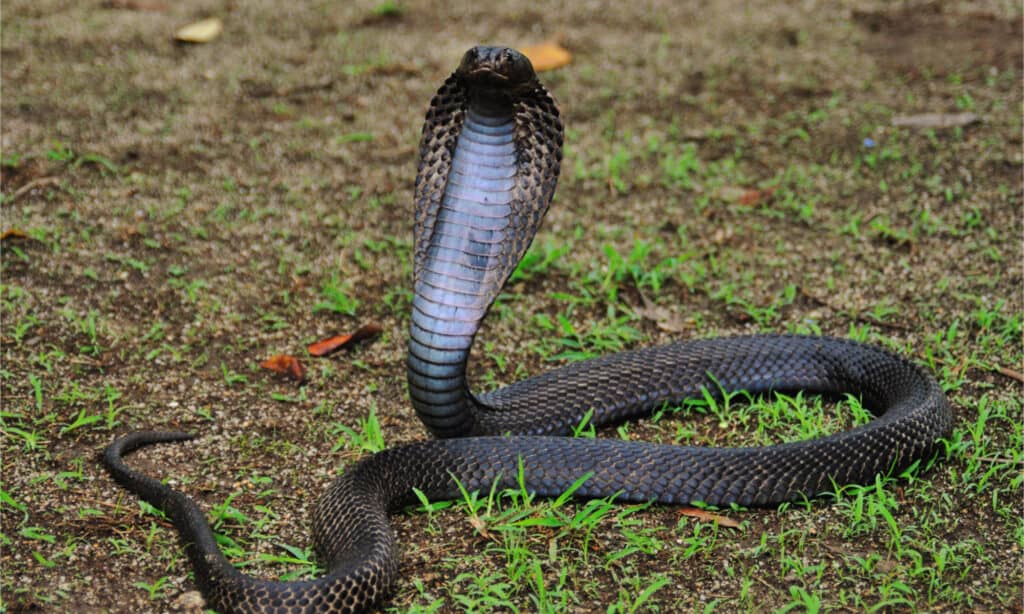
Equatorial spitting cobras are solid black or yellow with some spotting along their hoods.
©Reptilian/Shutterstock.com
Cobra venom is primarily neurotoxic, including that of the equatorial spitting cobra. Its front-located fangs are hollow and can inject a fatal venom dose. However, their fangs also have an opening on the front, which is how they “spit” venom. While they don’t technically spit and instead squeeze the venom out through their fang opening, the effect is no less terrifying and accurate.
This species also has a percentage of cytotoxic venom that varies depending on their location, because what self-respecting venomous snake wouldn’t be able to also destroy other tissues? Fortunately, although equatorial spitting cobra venom acts fast, an antivenom is available.
King Cobra (Ophiophagus hannah)
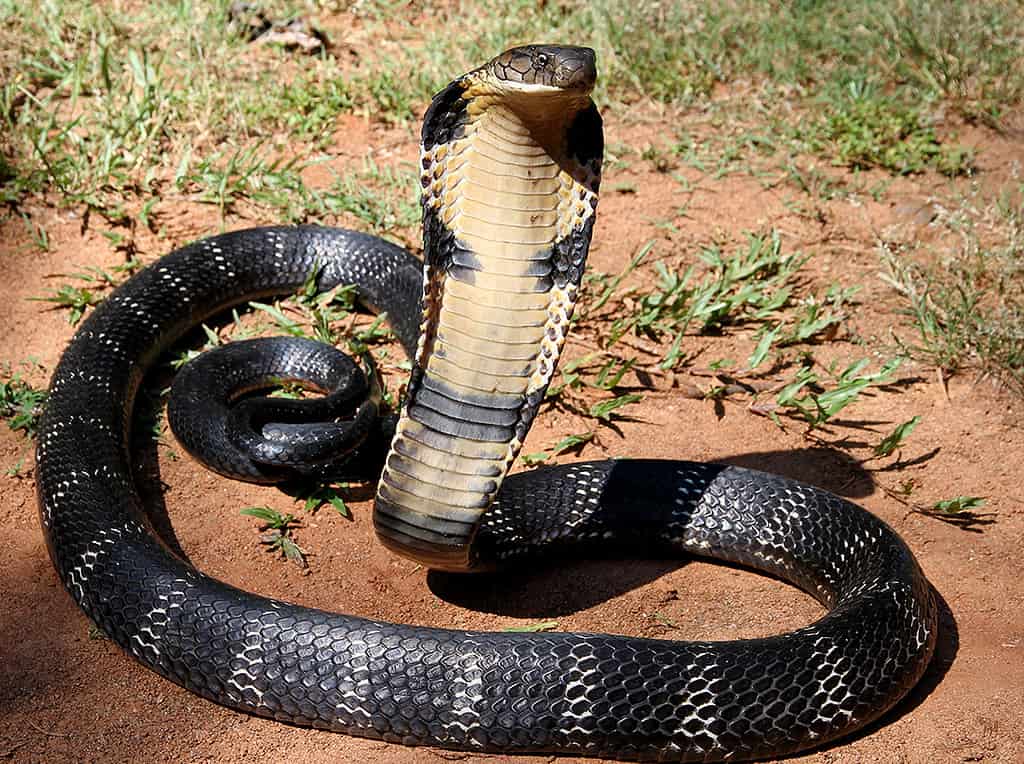
Although notorious for their size, king cobras generally avoid people.
©Michael Allen Smith from Seattle, USA, CC BY-SA 2.0 – License
The king of the forest is the longest venomous snake in the world. King cobras have enough venom to kill 11 humans — even though they would rather retreat. Their neurotoxic venom makes quick work of their typical serpentine prey and, although there is antivenom available, it must be administered quickly.
Texas Coral Snakes (Micrurus tener)
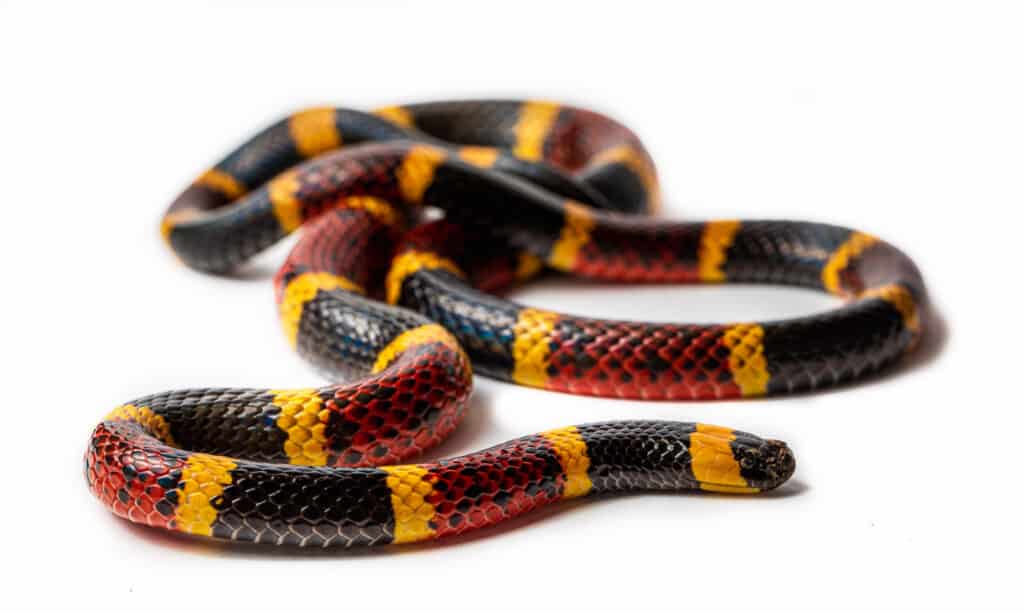
The Texas Coral Snake has a narrow body with colorful rings that go all the way around.
©Scott Delony/Shutterstock.com
Texas coral snakes have a nasty bite with neurotoxic venom. They’re part of the Elapidae family, just like cobras, but because of their size, they can’t produce much venom. Drop for drop, it’s far more dangerous than a cottonmouth, but the volume is so much smaller that it is easily treated with antivenom.
Despite what you may have heard, yes there is coral snake antivenom. However, for a while the company that produced it stopped making it, but has since restarted production.
Western Green Mamba (Dendroaspis viridis)
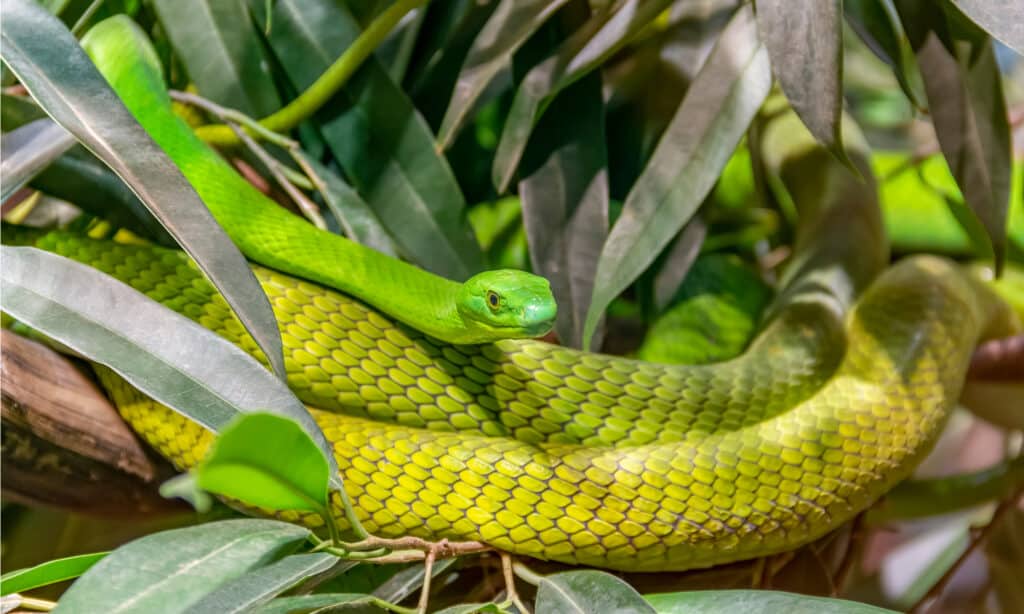
Western green mambas have neurotoxic venom that can kill a human in as little as 30 minutes.
©PRILL/Shutterstock.com
Primarily arboreal, western green mambas have complex venom that’s unusually quick-acting, often causing symptoms in less than 15 minutes. Fortunately, western green mambas are shy and don’t bite many people. These snakes only rarely leave their treetop homes, and usually only to find a mate or chase prey.
This snake’s paralyzing venom contains neurotoxic compounds that affect the lungs. Some local swelling also occurs, but the biggest problem is the neurotoxins.
Banded Krait (Bungarus fasciatus)
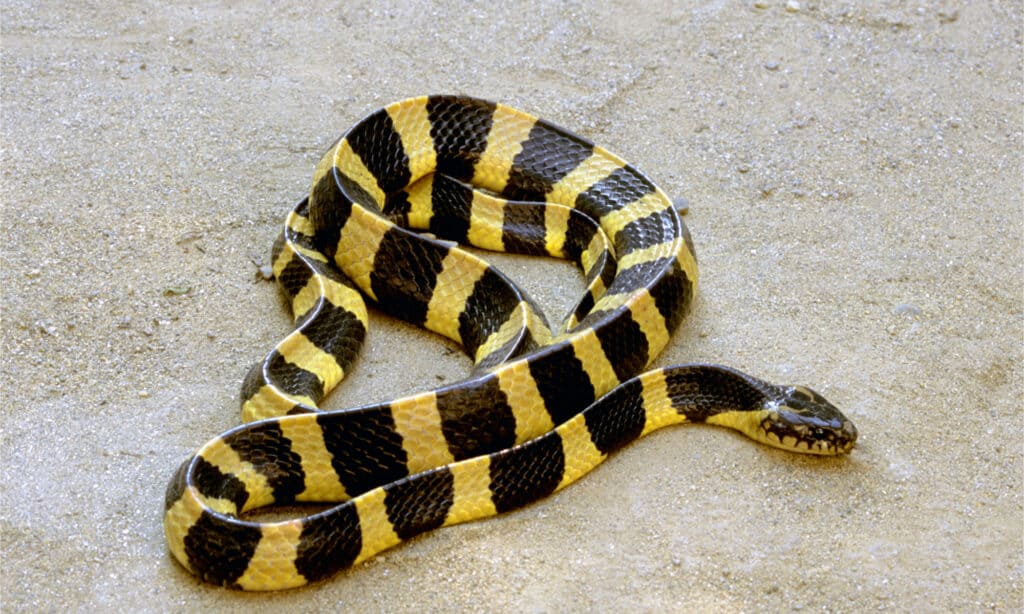
Banded kraits can reach 6.5 feet long and have a deadly bite.
©RealityImages/Shutterstock.com
According to an article published in the 2016 Journal of Venomous Animals and Toxins including Tropical Diseases, kraits are a leading cause of snakebite mortality in South Asia. However, it’s usually attributed to common kraits and black kraits.
Banded kraits are shy and docile, and don’t bite as many people. We still don’t recommend handling one of these beautiful “danger noodles.” Their venom is full of deadly neurotoxins.
Yellow-Bellied Sea Snakes (Hydrophis platurus)
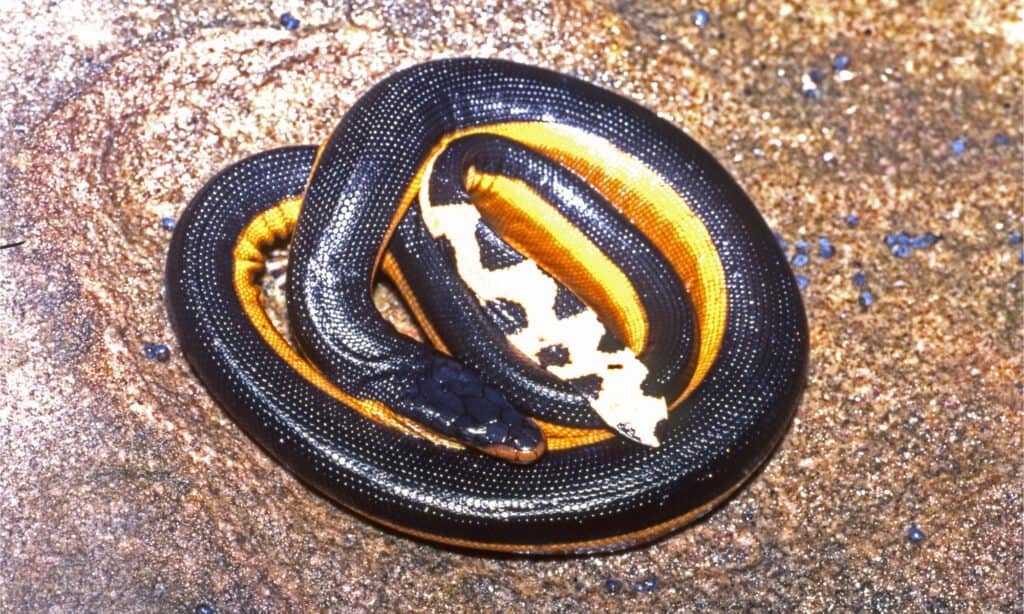
Yellow-bellied sea snakes have paddle-shaped tails that they use as a rudder.
©Ken Griffiths/Shutterstock.com
This species almost never leaves the water. Yellow-bellied sea snakes’ bodies are uniquely adapted to thrive in the ocean and usually hunt in kelp forests.
Their deadly venom contains neurotoxins and myotoxins which result in paralysis, swelling in the tongue and joints, blurry vision, vomiting, and sometimes death.
Neotropical Rattlesnake (Crotalus durissus)
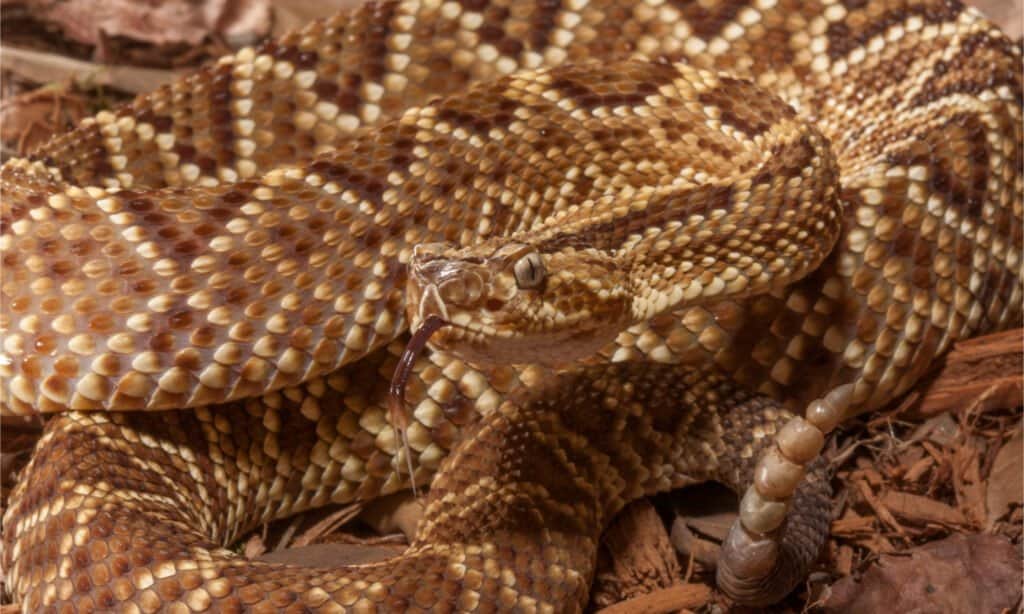
The neotropical rattlesnake has several subspecies.
©K Hanley CHDPhoto/Shutterstock.com
All but a few North American rattlers have hemotoxic venom, but as you move south through their territory, more species produce neurotoxic venom. One such rattlesnake is the neotropical or South American rattlesnake.
This species packs a wallop and can kill a person with their venom. Some subspecies have more toxic venom than others, but all have some form of neurotoxic venom.
Timber Rattlesnake (Crotalus horridus)
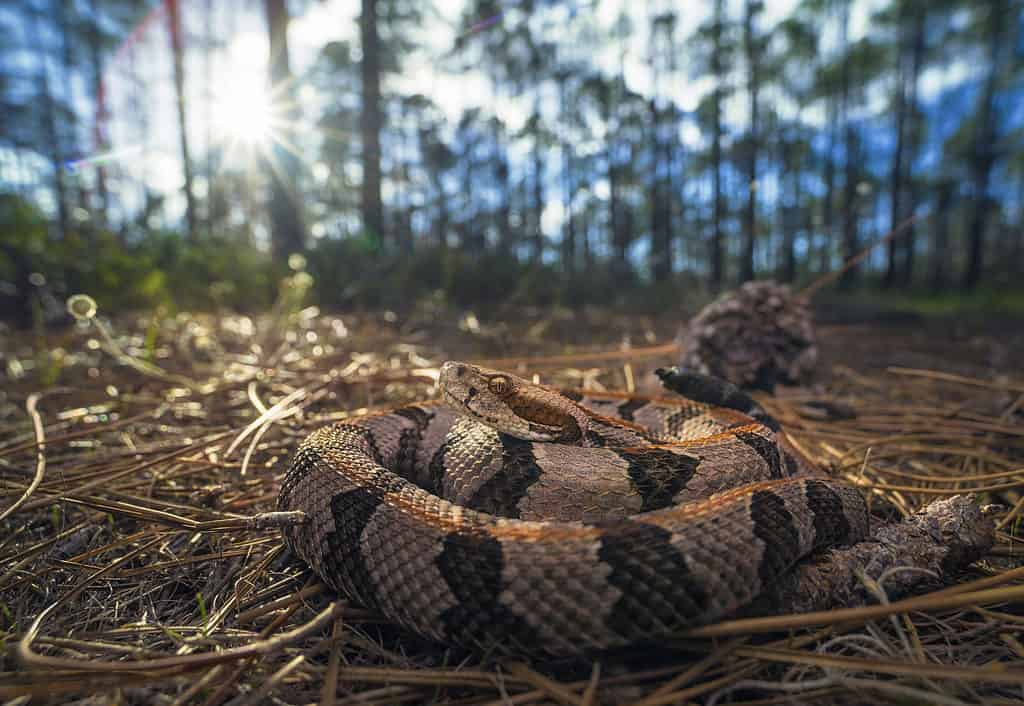
Some timber
rattlesnakes
have neurotoxic venom, but some don’t.
©Kristian Bell/Shutterstock.com
Timber rattlesnakes can have one of four different venom profiles. Those in the southern range tend to have type A, which is primarily neurotoxic. It’s the most dangerous venom type for this species. Fortunately, although they are big and can inject a lot of venom, they’re also docile and don’t want to bite you.
Mojave Rattlesnake (Crotalus scutulatus)
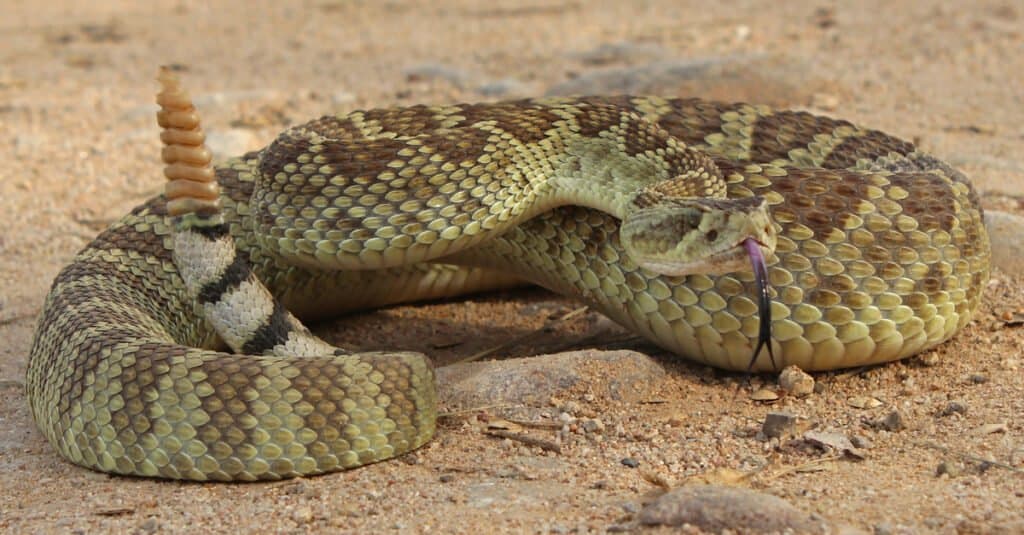
Mojave rattlesnakes have a uniquely dangerous neurotoxin in their venom.
©Creeping Things/Shutterstock.com
Although it’s often mistaken for the western diamondback rattlesnake, mojave rattlesnakes pack much more dangerous bite. Scientists say this snake often has hemotoxic venom, but some populations have a neurotoxic component called Mojave toxin. Previously, researchers believed that it was somewhat isolated, but the neurotoxic variant is more common than they previously thought.
Eastern Brown Snake (Pseudonaja textilis)
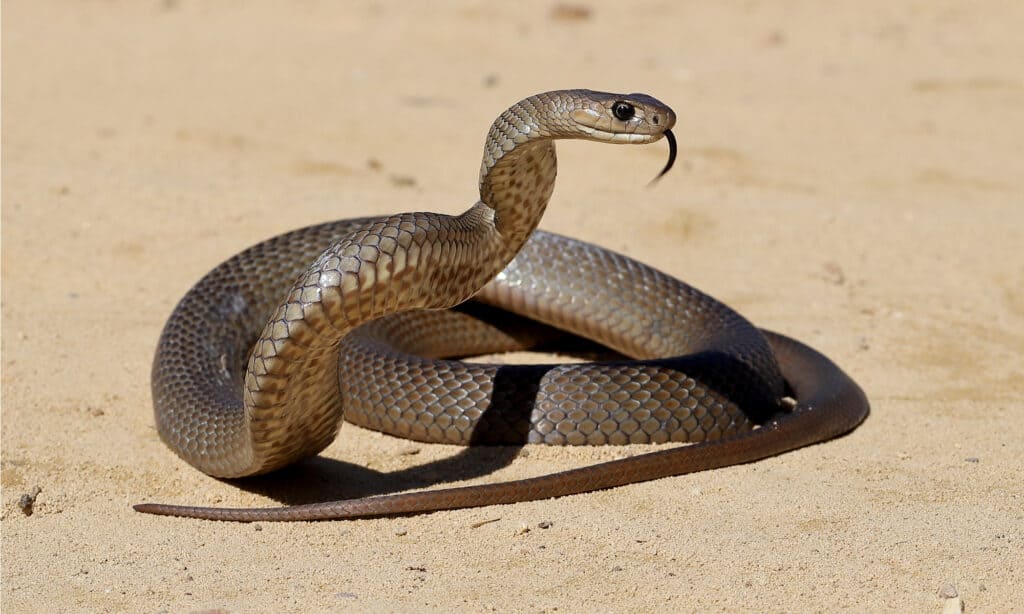
Australian Highly venomous Eastern Brown Snake in striking position
©Ken Griffiths/Shutterstock.com
Australia’s eastern brown snake is responsible for more snakebites than any other venomous snake in Australia. This snake packs a nasty punch, full of cardiotoxins, coagulants, and neurotoxins. Fortunately, they don’t often envenomate, and they don’t inject very much venom in a bite.
Berg Adder (Bitis atropos)
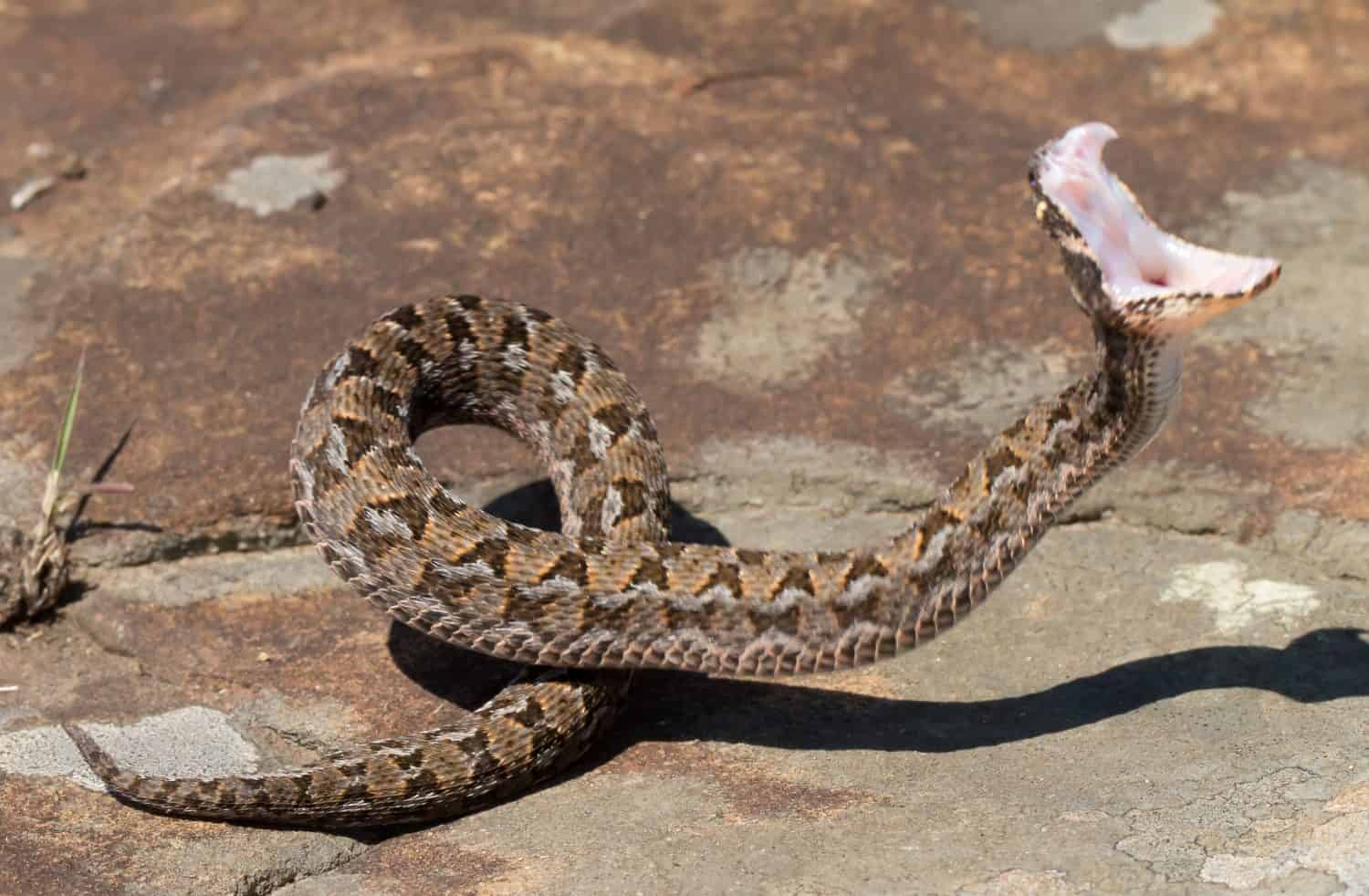
Berg adders are cranky and quick to strike — often injecting their dangerous neurotoxic venom.
©Andre Coetzer/Shutterstock.com
Small but mighty. Berg adders may only grow to about two feet long, but they are highly venomous and possess a potent paralyzing venom. In addition, they are quick to strike and somewhat cranky. They haven’t been studied as extensively as some of the other members of the Bitis genus, but a 2021 study showed that all Bitis vipers have varying amounts of neurotoxins in their venom.
Common Death Adder (Acanthophis antarcticus)
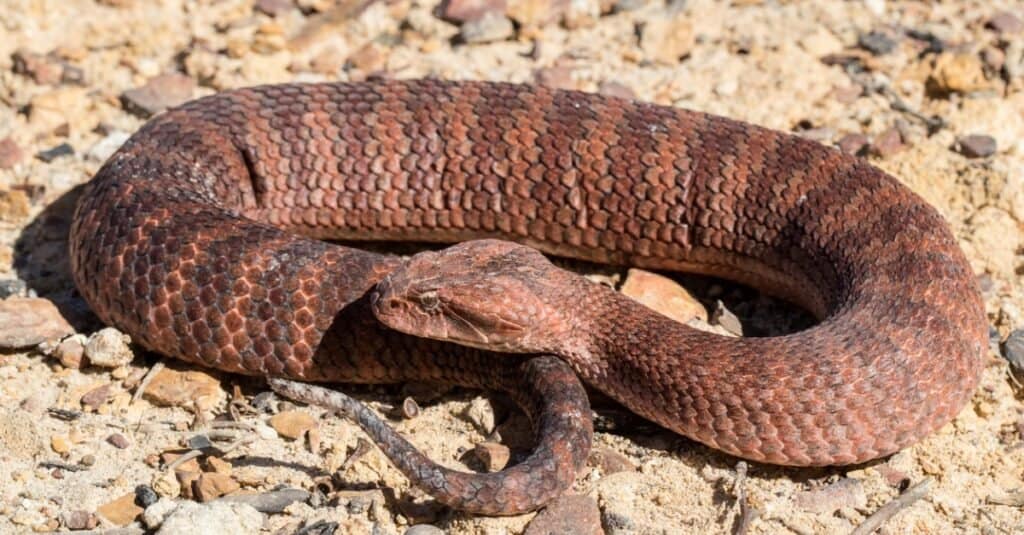
The common death adder has the longest fangs of any venomous Australian snake.
©iStock.com/Ken Griffiths
This species may look like a viper, but it is an elapid. Common death adders are one of Australia’s most venomous snakes, but they rarely bite. Their neurotoxic venom is a nasty bit of evolution and even though antivenom can effectively bind the venom circulating in a person’s blood, the neurotoxic effects linger for over a day.
Mangrove snake (Boiga dendrophila)
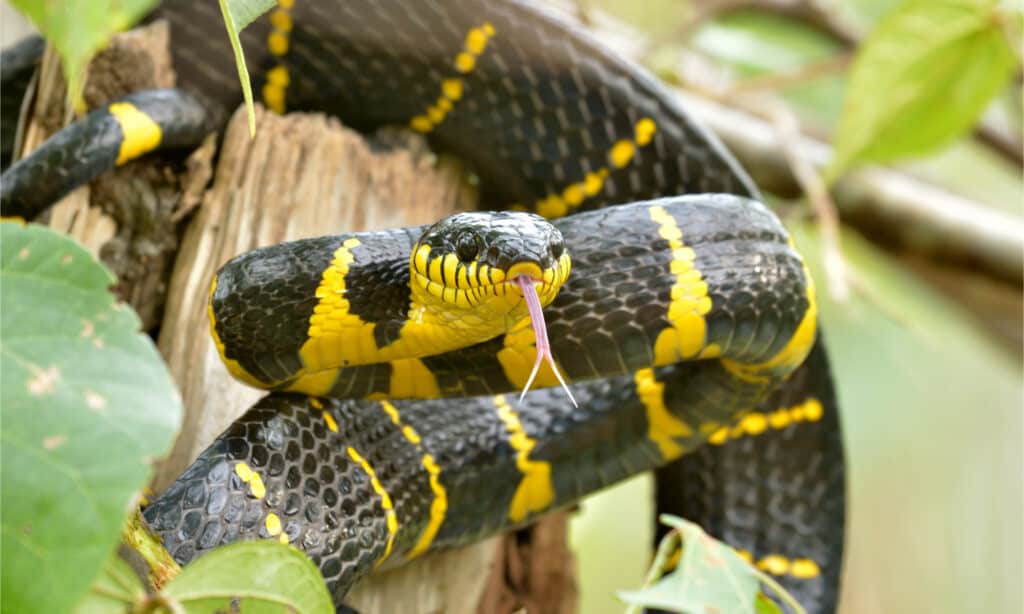
Although mangrove snakes have venom made primarily of denmotoxins, a bird specific neurotoxin.
©YapAhock/Shutterstock.com
Mangrove snakes have weak venom containing mostly denmotoxins, which are a type of parazyzing neurotoxin. However, it’s the first venom that scientists confirm as being bird-specific.
These snakes have small rear fangs and, like garter snakes, must chew in order to release their venom. Their fangs are so small that they can’t open their mouths far enough to get a good mouthful of a person.
Highland Copperhead (Austrelaps ramsayi)
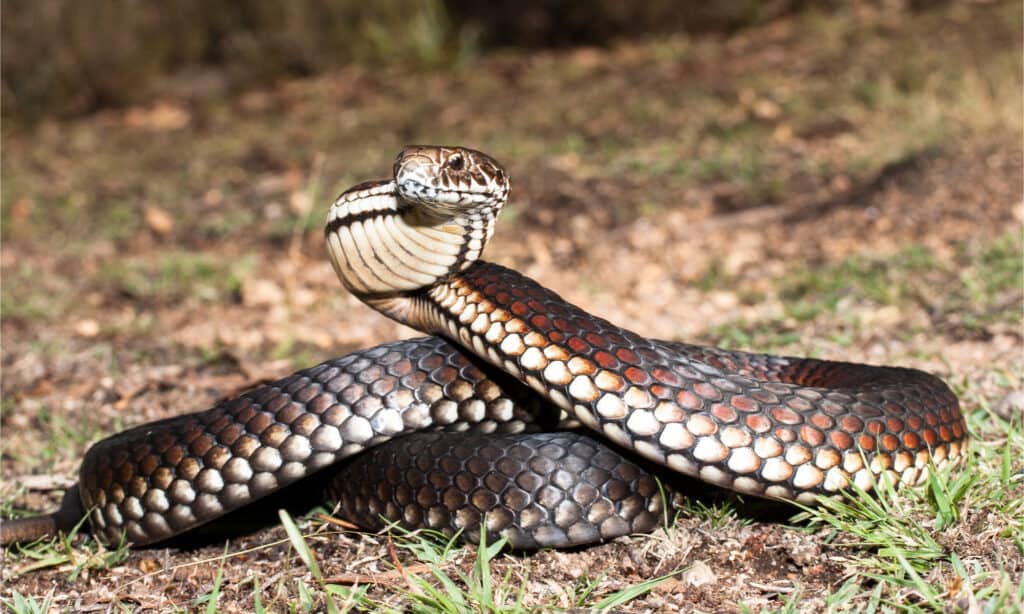
These snakes possess very dangerous neurotoxic venom.
©Ken Griffiths/Shutterstock.com
Unlike the American copperhead snakes, the highlands copperhead is an elapid native to Australia. These often reclusive and shy snakes hesitate to bite. However, if they bite, the venom is a dangerous cocktail containing various neurotoxins.
Common Garter Snake (Thamnophis sirtalis)
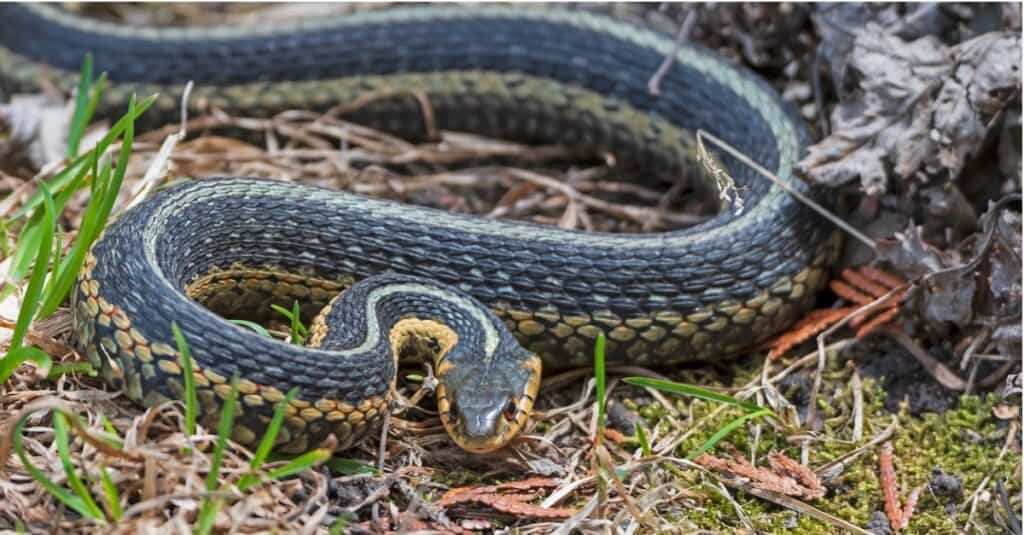
Garter snakes have a Duvorney’s gland, where they produce mild neurotoxic venom.
©iStock.com/Wildnerdpix
In a scientific surprise, researchers discovered that garter snakes have enlarged teeth in the back of their mouth and release a mild prey-specific paralyzing venom. For years, we believed they were nonvenomous, but now…nope! Even the humble, harmless-to-humans garter snake can pack a punch to a frog.
Inland Taipan (Oxyuranus microlepidotus)
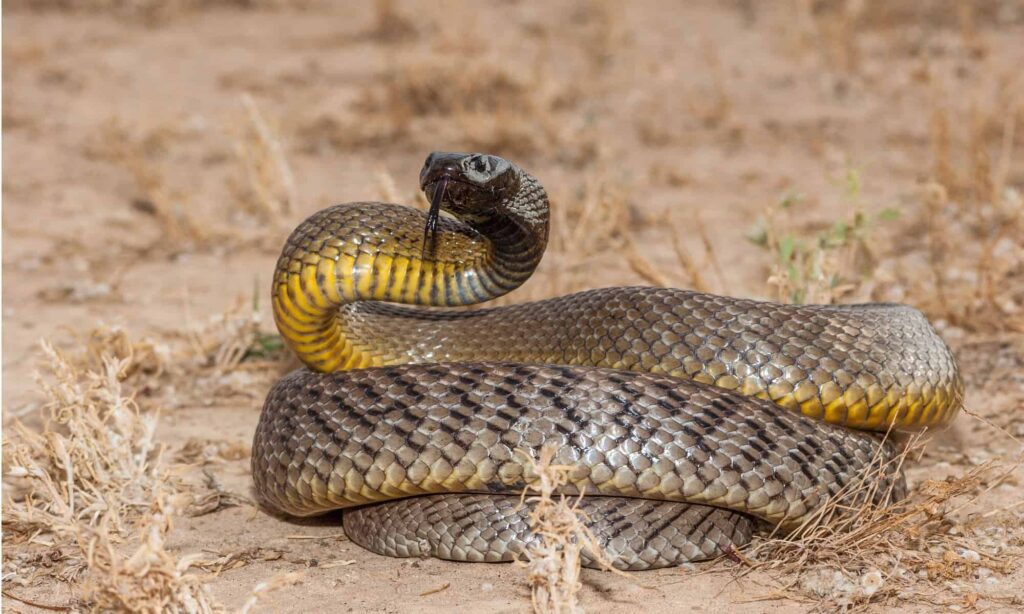
One of the most deadly snakes in the world, inland taipan venom contains hemotoxins and myotoxins in addition neurotoxins.
©Ken Griffiths/Shutterstock.com
Inland taipans are often confused with coastal taipans, but these extremely venomous snakes are shy and reclusive. Bites are rare, in contrast with coastal taipans who bite more frequently.
However shy they are, inland taipans have one heck of a venom cocktail, comprised mostly of neurotoxins with a smattering of blood-clot-affecting hemotoxins and muscle-damaging myotoxins.
Rinkhals (Haemachatus haemachatus)
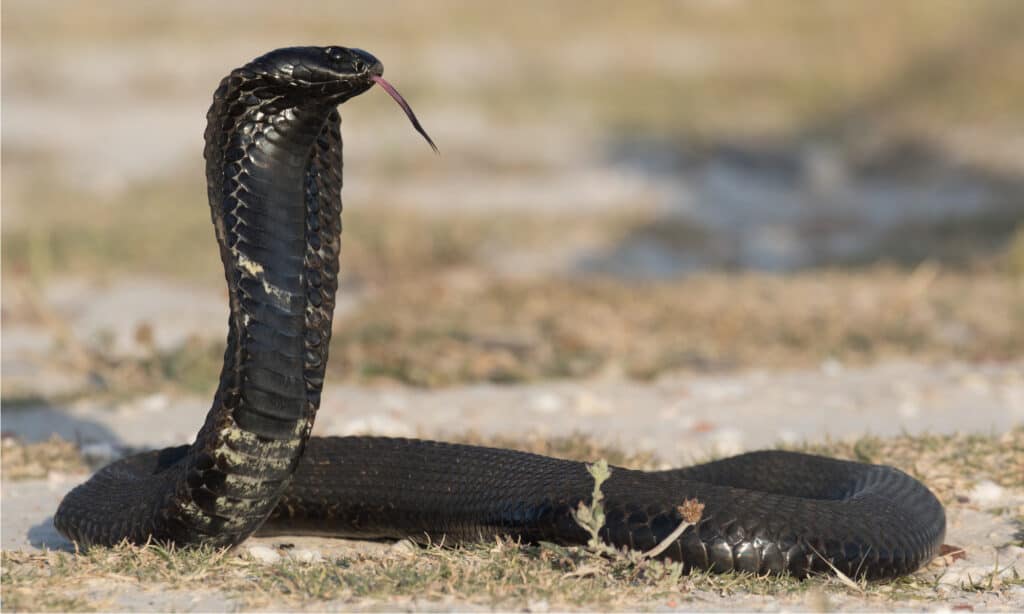
Although not true cobras, rinkhals look like them and possess similarly dangerous neurotoxic venom.
©Andre Coetzer/Shutterstock.com
Also called ring-necked spitting cobras, rinkhals’ most obvious difference from true cobras is that they have keeled scales. Like king cobras, they’re the only snake in their genus, also known as a monotypic genus. However, their neurotoxins don’t just get injected via fangs. These snakes have specialized holes in the front of the fangs that allow them to forcibly eject it in your eyes.
3 Main Venom Types
Even though there are different venoms everywhere, they fall under three main types: neurotoxic, hemotoxic, and cytotoxic. Many species have varying quantities of different toxins, but most often have one primary type.
Neurotoxic Venom can act very quickly, but not always. It may take 24 hours to begin seeing symptoms, but by then it may be too late for treatment. It works by attacking the nervous system and stopping the transmission of signals from the nerves to the muscles. When those signals are interrupted, your brain won’t be able to control bodily functions — whether that’s moving your fingers or making your heart pump.
Most snake species in the Elapidae family produce neurotoxic venom. It’s what you’ll hear most when people refer to neurotoxic venom. However, they aren’t alone in producing neurotoxic venom. Other species have toxic cocktails of paralysis-causing venom too.
Hemotoxic Venom is neurotoxic venom’s more dramatic cousin. It directly attacks red blood cells and causes hemorrhaging, tissue death, and organ damage. Left untreated, a severe envenomation can kill the victim — painfully and slowly.
Cytotoxic Venom is very painful and destroys cell membranes. Anything from blood vessels to muscle tissue and bone can be affected, leading to amputations, gangrene when untreated, and sometimes death.
What To Do If You Get Bitten By A Snake
Most snakebite fatalities happen because the victim either could not or chose not to seek medical attention. Venomous snakebites are not something you should ever ignore.
Here are a few tips to help:
- Do not delay in seeking medical attention.
- Don’t suck out the venom. You’ll fail and probably hurt yourself more.
- Remove all restrictive clothing and jewelry.
- Keep the affected body part below your heart.
The photo featured at the top of this post is © samray/Shutterstock.com
Discover the "Monster" Snake 5X Bigger than an Anaconda
Every day A-Z Animals sends out some of the most incredible facts in the world from our free newsletter. Want to discover the 10 most beautiful snakes in the world, a "snake island" where you're never more than 3 feet from danger, or a "monster" snake 5X larger than an anaconda? Then sign up right now and you'll start receiving our daily newsletter absolutely free.
Thank you for reading! Have some feedback for us? Contact the AZ Animals editorial team.






